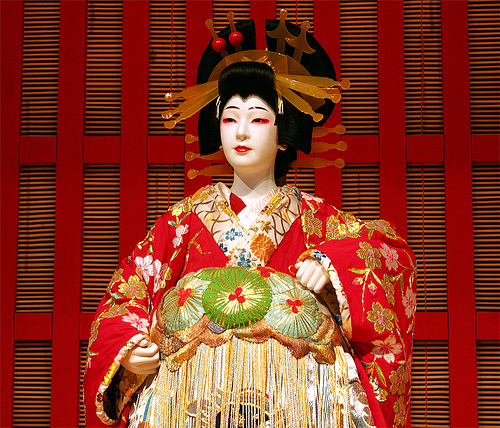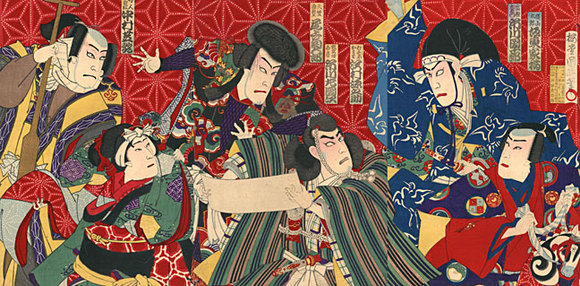-to Omoimasu/(I) think ……
(Kabuki: Do you believe this is a MAN?)
[Rules of This Sentence Pattern]
- Stating the speaker’s impression or opinion.
- Stating the speaker’s conjecture or judgement.
- You can ask the listener’s impression, opinion, and/or judgement by using “-to Omoimasuka.
[Examples]
- Watashi-wa Ame-ga Furu-to Omoimasu. (= I think it will rain tomorrow.)
- Sensei-wa Gurando-ni Iru-to Omoimasu. (= I think the teacher is in the playground.)
- Naoko: Tanaka-san-mo Kino-no Paati-ni Itta-to Omoimasuka. (= Do you think Mr. Tanaka went to the party yesterday?) Toshihiko: Iie, Ikanakatta-to Omoimasu. (= No, I don’t think he did.)
- Kabuki-wa Omoshiroi-to Omoimasu. (= I think Kabuki is interesting.)
- Suzuki-san-no Inu-wa Totemo Kawaii-to Omoimasu. (= I think Mr. Suzuki’s dog is very cute.)
- Sanae: Ashita-mo Samui-to Omoimasuka. (= Do you think it is going to be cold tomorrow too?) Kota: “Hai, Samui-to Omoimasu.” (= Yes, I think it will be cold tomorrow.)
- Koji: Kino Itta Resutoran-no Ryori-wa Oishii-to Omoimasuka. (= Do you think the food served in the restaurant where we went are good enough?) Tamiko: Iie, Amari Oishikunai-to Omoimasu. (= No, I don’t think they were very good.)
- Romaji-wa Benrida-to Omoimasu. (= I think Romaji is convenient.)
- Mukashi, Koko-wa Nigiyakadatta-to Omoimasu. (= I think it was lively here in the past.)
- Yamamoto-san-no Otosan-wa 40-sai Guraida-to Omoimasu. (= I think Mr. Yamamoto’s father is around 40 years old.)
- Setsuko: Kore-wa Dare-no Kabandesuka. (= Whose bag is this?) Koichi: Yoshimoto-san-no Kabanda-to Omoimasu. (= I think that is Mr. Yoshimoto’s.)
- Takeshi: Kore-wa Nanda-to Omoimasuka. (= What do you think this is?) Ayako: Saa, Wakarimasen. (= Well, I have no idea.)
(Ukiyoe of Kabuki)
Now you have learned the patterns of ” -to Omoimasu,” haven’t you? Yes, you can make sentences like those above to state your opinion or judgement.
Here are the sentences you hear very often at school in Japan. The situation is ‘Japanese History Class.’
Kinoshita Sensei (Mr. Kinoshita): Kino-no Fukushu-wo Shimasho. (= “Let’s review what we learned yesterday.”) Inukai Tsuyoshi-wa Dare-ni Korosaremashitaka. (“Who killed Inukai Tsuyoshi?”) Shoji-kun Kimi-wa Oboeteimasuka. (Do you remember what you learned in my class yesterday, Mr. Shoji?”)
Shoji-kun (Mr. Shoji): Seinen Shoko da-to Omoimasu. (= I think Inukai was killed by young military/naval officers.)
Please pay a special attention to this conversation which occurred at school. Mr. Kinoshita’s class learned the historical incident called 5.15 Jiken (= May 15 Incident: https://en.wikipedia.org/wiki/May_15_Incident), where Mr. Tsuyoshi Inukai (https://en.wikipedia.org/wiki/Inukai_Tsuyoshi), the Prime Minister of Japan, was assassinated by young military and naval officers at home in 1932. This is a FACT, NOT an opinion or a judgement. So, this student named Mr. Shoji (This is his last name!) was supposed to say, “Seinen Shoko desu.” Easy, isn’t it? But, the Japanese including students tend NOT to say like that even though they know their answer is absolutely right. This is the Japanese! Totally different from Americans, folks! The Japanese are trained to be as HUMBLE as possible – ARROGANCE is the last thing they appreciate in the world. They always try to sound as soft as possible, which tends to be regarded as weak, but the truth is the Japanese prefer not to show off. This is Japanese culture.
If you keep translating English sentences directly into Japanese, you will soon find yourself outcast. You must learn the cultural aspects like this thoroughly if you wish to become a master speaker of Japanese language!
I will show you how!
Special Trial Lesson $19.99 <– Click here!
ONLY 19 SPOTS LEFT!
HURRY!





